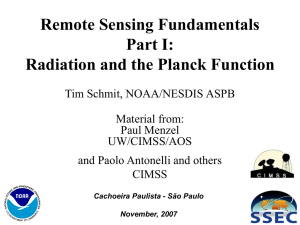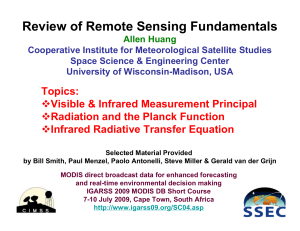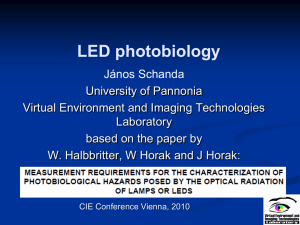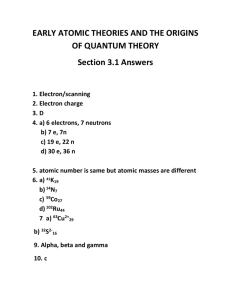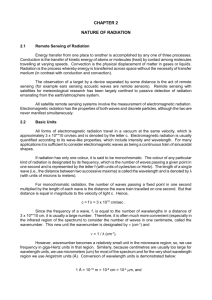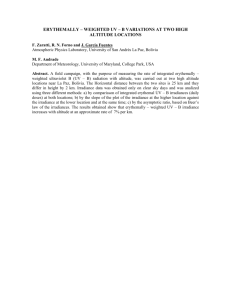Lecture 1 – Planck Function, Radiation(Paul Menzel)
advertisement
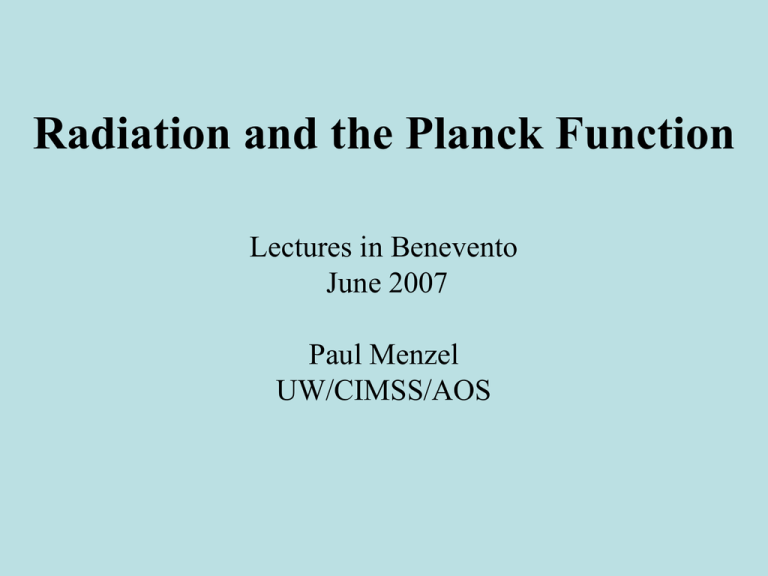
Radiation and the Planck Function
Lectures in Benevento
June 2007
Paul Menzel
UW/CIMSS/AOS
All satellite remote sensing systems involve the
measurement of electromagnetic radiation.
Electromagnetic radiation has the properties of both
waves and discrete particles, although the two are
never manifest simultaneously.
Electromagnetic radiation is usually quantified
according to its wave-like properties; for many
applications it considered to be a continuous train of
sinusoidal shapes.
The Electromagnetic Spectrum
Remote sensing uses radiant energy that is reflected and emitted from
Earth at various “wavelengths” of the electromagnetic spectrum
Our eyes are sensitive to the visible portion of the EM spectrum
Radiation is characterized by wavelength and amplitude a
Terminology of radiant energy
Energy from
the Earth Atmosphere
over time is
Flux
which strikes the detector area
Irradiance
at a given wavelength interval
Monochromatic
Irradiance
over a solid angle on the Earth
Radiance observed by
satellite radiometer
is described by
The Planck function
can be inverted to
Brightness temperature
Definitions of Radiation
__________________________________________________________________
QUANTITY
SYMBOL
UNITS
__________________________________________________________________
Energy
dQ
Joules
Flux
dQ/dt
Joules/sec = Watts
Irradiance
dQ/dt/dA
Watts/meter2
Monochromatic
Irradiance
dQ/dt/dA/d
W/m2/micron
or
Radiance
dQ/dt/dA/d
W/m2/cm-1
dQ/dt/dA/d/d
W/m2/micron/ster
or
dQ/dt/dA/d/d
W/m2/cm-1/ster
__________________________________________________________________
Radiation from the Sun
The rate of energy transfer by electromagnetic radiation is called the radiant flux,
which has units of energy per unit time. It is denoted by
F = dQ / dt
and is measured in joules per second or watts. For example, the radiant flux from
the sun is about 3.90 x 10**26 W.
The radiant flux per unit area is called the irradiance (or radiant flux density in
some texts). It is denoted by
E = dQ / dt / dA
and is measured in watts per square metre. The irradiance of electromagnetic
radiation passing through the outermost limits of the visible disk of the sun (which
has an approximate radius of 7 x 10**8 m) is given by
3.90 x 1026
E (sun sfc)
= 6.34 x 107 W m-2 .
=
4 (7 x 108)2
The solar irradiance arriving at the earth can be calculated by realizing that the flux is a
constant, therefore
E (earth sfc) x 4πRes2 = E (sun sfc) x 4πRs2,
where Res is the mean earth to sun distance (roughly 1.5 x 1011 m) and Rs is the solar
radius. This yields
E (earth sfc) = 6.34 x 107 (7 x 108 / 1.5 x 1011)2 = 1380 W m-2.
The irradiance per unit wavelength interval at wavelength λ is called the monochromatic
irradiance,
Eλ = dQ / dt / dA / dλ ,
and has the units of watts per square metre per micrometer. With this definition, the
irradiance is readily seen to be
E
=
Eλ dλ .
o
In general, the irradiance upon an element of surface area may consist of contributions which
come from an infinity of different directions. It is sometimes necessary to identify the part of
the irradiance that is coming from directions within some specified infinitesimal arc of solid
angle dΩ. The irradiance per unit solid angle is called the radiance,
I = dQ / dt / dA / dλ / dΩ,
and is expressed in watts per square metre per micrometer per steradian. This quantity is
often also referred to as intensity and denoted by the letter B (when referring to the Planck
function).
If the zenith angle, θ, is the angle between the direction of the radiation and the normal to the
surface, then the component of the radiance normal to the surface is then given by I cos θ.
The irradiance represents the combined effects of the normal component of the radiation
coming from the whole hemisphere; that is,
E = I cos θ dΩ
where in spherical coordinates dΩ = sin θ dθ dφ .
Ω
Radiation whose radiance is independent of direction is called isotropic radiation. In this
case, the integration over dΩ can be readily shown to be equal to so that
E=I.
Radiation is governed by Planck’s Law
c2 /T
B(,T) = c1 /{ 5 [e
-1] }
Summing the Planck function at one temperature
over all wavelengths yields the energy of the
radiating source
E = B(, T) = T4
Brightness temperature is uniquely related to
radiance for a given wavelength by the Planck
function.
Using wavelengths
c2/T
B(,T) = c1 / 5 / [e
-1]
Planck’s Law
where
(mW/m2/ster/cm)
= wavelengths in cm
T = temperature of emitting surface (deg K)
c1 = 1.191044 x 10-5 (mW/m2/ster/cm-4)
c2 = 1.438769 (cm deg K)
dB(max,T) / d = 0 where (max) = .2897/T
Wien's Law
indicates peak of Planck function curve shifts to shorter wavelengths (greater wavenumbers)
with temperature increase. Note B(max,T) ~ T5.
Stefan-Boltzmann Law E = B(,T) d = T4, where = 5.67 x 10-8 W/m2/deg4.
o
states that irradiance of a black body (area under Planck curve) is proportional to T4 .
Brightness Temperature
c1
T = c2 / [ ln( _____ + 1)] is determined by inverting Planck function
5B
Spectral Distribution of Energy Radiated
from Blackbodies at Various Temperatures
B(max,T) T5
B(max,6000) ~ 3.2 x 107
B(max,300) ~ 1 x 101
so
B(max,6000) / B(max,300) ~ 3 x 106
and
(6000/300)5 = (20)5 = 3.2 x 106
which is the same
Bλ/Bλmax
Area / 3
2x Area /3
Using wavenumbers
c2/T
B(,T) = c13 / [e
-1]
Planck’s Law
where
(mW/m2/ster/cm-1)
= # wavelengths in one centimeter (cm-1)
T = temperature of emitting surface (deg K)
c1 = 1.191044 x 10-5 (mW/m2/ster/cm-4)
c2 = 1.438769 (cm deg K)
dB(max,T) / d = 0 where ν(max) = 1.95T
Wien's Law
indicates peak of Planck function curve shifts to shorter wavelengths (greater wavenumbers)
with temperature increase. Note B(max,T) ~ T**3.
Stefan-Boltzmann Law E = B(,T) d = T4, where = 5.67 x 10-8 W/m2/deg4.
o
states that irradiance of a black body (area under Planck curve) is proportional to T4 .
Brightness Temperature
c13
T = c2/[ln(______ + 1)] is determined by inverting Planck function
B
B /Bmax
B(max,T)~T5
B(max,T)~T3
Planck Radiances
180
160
B(,T)
140
mW/m2/ster/cm (cm-1)
120
100
80
B(,T)
60
40
20
0
0
5
10
15
20
wavenumber (in hundreds)
B(,T) versus B(,T)
25
30
Using wavenumbers
Using wavelengths
c2/T
B(,T) = c13 / [e
-1]
(mW/m2/ster/cm-1)
c2 /T
B(,T) = c1 /{ 5 [e
-1] }
(mW/m2/ster/m)
(max in cm-1) = 1.95T
(max in cm)T = 0.2897
B(max,T) ~ T**3.
B( max,T) ~ T**5.
E = B(,T) d = T4,
o
c13
T = c2/[ln(______ + 1)]
B
E = B(,T) d = T4,
o
c1
T = c2/[ ln(______ + 1)]
5 B
Temperature sensitivity, or the percentage change in radiance corresponding to a
percentage change in temperature, , is defined as
dB/B = dT/T.
The temperature sensivity indicates the power to which the Planck radiance depends
on temperature, since B proportional to T satisfies the equation. For infrared
wavelengths,
= c2/T = c2/T.
__________________________________________________________________
Wavenumber
700
900
1200
1600
2300
2500
Typical Scene
Temperature
220
300
300
240
220
300
Temperature
Sensitivity
4.58
4.32
5.76
9.59
15.04
11.99
dB/B = dT/T or B = c T where = c2/T for a small temperature window around T.
B = B(T0) + (dB/dT)0 (ΔT) + (d2B/dT2 )0(ΔT)2 + O(3)
negligible
So to first order
c (T0 + ΔT) = c T0 + c T0 -1 (ΔT)
c (T0 + ΔT) - c T0 = c T0 -1 (ΔT)
ΔB = c T0 -1 (ΔT)
ΔB/B = ΔT/T
Also to first order
(T0 + ΔT) = T0 + T0 -1 (ΔT)
Temperature Sensitivity of B(λ,T) for typical earth scene temperatures
B (λ, T) / B (λ, 273K)
4μm
6.7μm
2
10μm
15μm
microwave
1
200
250
Temperature (K)
300
B(10 um,T) / B(10 um,273) T4
B(10 um,273)= 6.1
B(10 um,200)= 0.9 0.15
B(10 um,220)= 1.7 0.28
B(10 um,240)= 3.0 0.49
B(10 um,260)= 4.7 0.77
B(10 um,280)= 7.0 1.15
B(10 um,273)= 9.9 1.62
1
200
300
B(4 um,T) / B(4 um,273) T12
B(4 um,273)= 2.2 x 10-1
B(4 um,200)= 1.8 x 10-3 0.0
B(4 um,220)= 9.2 x 10-3 0.0
B(4 um,240)= 3.6 x 10-2 0.2
B(4 um,260)= 1.1 x 10-1 0.5
B(4 um,280)= 3.0 x 10-1 1.4
B(4 um,273)= 7.2 x 10-1 3.3
1
200
300
B(0.3 cm, T) / B(0.3 cm,273) T
B(0.3 cm,273)= 2.55 x 10-4
B(0.3 cm,200)= 1.8 0.7
B(0.3 cm,220)= 2.0 0.78
B(0.3 cm,240)= 2.2 0.86
B(0.3 cm,260)= 2.4 0.94
B(0.3 cm,280)= 2.6 1.02
B(0.3 cm,273)= 2.8 1.1
1
200
300
Radiation is governed by Planck’s Law
c2 /T
B(,T) = c1 /{ 5 [e
-1] }
In microwave region c2 /λT << 1 so that
c2 /T
e
= 1 + c2 /λT + second order
And classical Rayleigh Jeans radiation equation emerges
Bλ(T) [c1 / c2 ] [T / λ4]
Radiance is linear function of brightness temperature.
Cloud edges and broken clouds appear different in 11 and 4 um images.
T(11)**4=(1-N)*Tclr**4+N*Tcld**4~(1-N)*300**4+N*200**4
T(4)**12=(1-N)*Tclr**12+N*Tcld**12~(1-N)*300**12+N*200**12
Cold part of pixel has more influence for B(11) than B(4)
Table 6.1 Longwave and Shortwave Window Planck Radiances (mW/m**2/ster/cm-1)
and Brightness Temperatures (degrees K) as a function of Fractional Cloud Amount (for
cloud of 220 K and surface of 300 K) using B(T) = (1-N)*B(Tsfc) + N*B(Tcld).
Cloud
Fraction N
Longwave Window
Rad
Temp
Shortwave Window
Rad
Temp
Ts -T1
1.0
23.5
220
.005
220
0
.8
42.0
244
.114
267
23
.6
60.5
261
.223
280
19
.4
79.0
276
.332
289
13
.2
97.5
289
.441
295
6
.0
116.0
300
.550
300
0
T
SW and LW BTs for different cloud amounts
when Tcld=220 and Tsfc=300
300
BT4
280
BT11
260
240
220
1.0
0.8
0.6
0.4
0.2
0.0
N
N=0.8
8.6-11
N=0.6
N=1.0
N=0.4
N=0.2
N=0
11-12
Broken clouds appear different in 8.6, 11 and 12 um images;
assume Tclr=300 and Tcld=230
T(11)-T(12)=[(1-N)*B11(Tclr)+N*B11(Tcld)]-1
- [(1-N)*B12(Tclr)+N*B12(Tcld)]-1
T(8.6)-T(11)=[(1-N)*B8.6(Tclr)+N*B8.6(Tcld)]-1
- [(1-N)*B11(Tclr)+N*B11(Tcld)]-1
Cold part of pixel has more influence at longer wavelengths
Cold clouds appear grainy in 4 um MODIS images.
R = Rmax/ 213 and T = R / [dB/dT]
dB/dT(4) is 100 times smaller at 200 K than at 300K;
Truncation error in cold scenes for 4 m is several degrees K!
dB/dT(11) is only 4 times smaller (hence it is not noticeable).
NEDR vs NEDT at 4 and 11 m
B and dB/dT at 4 and 11 m
For GOES
with 10 bit data it is even worse
R = Rmax/ 210
and
T = R / [dB/dT]
W/m2/ster/um
